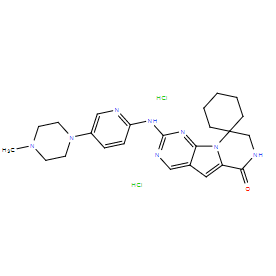| Cas No.: | 1977495-97-8 |
| Chemical Name: | Trilaciclib HCl |
| Synonyms: | G1T28 hydrochloride |
| SMILES: | CN1CCN(CC1)C2=CN=C(C=C2)NC3=NC=C4C=C5C(=O)NCC6(N5C4=N3)CCCCC6.Cl.Cl |
| Formula: | C24H32Cl2N8 |
| M.Wt: | 519.475 |
| Sotrage: | 2 years -20°C Powder, 2 weeks 4°C in DMSO, 6 months -80°C in DMSO |
| Description: | Trilaciclib hydrochloride is a CDK4/6 inhibitor with IC50s of 1 nM and 4 nM for CDK4 and CDK6, respectively. |
| In Vivo: | Trilaciclib hydrochloride (G1T28) treatment results in a robust and dose-dependent suppression of proliferation in HSPCs at 12 hours, with 5-ethynyl-2′-deoxyuridine (EdU) incorporation returning near baseline levels in a dose-dependent manner by 24 hours after administration. These data demonstrate that a single oral dose of Trilaciclib hydrochloride can produce reversible cell-cycle arrest in HSPCs in a dose-dependent manner in vivo. Mice given 100 mg/kg Trilaciclib hydrochloride 30 minutes prior to etoposide treatment, exhibits only background levels of caspase-3/7 activity. These data demonstrate that Trilaciclib hydrochloride can protect the bone marrow from chemotherapy-induced apoptosis in vivo. The data demonstrate that treatment with Trilaciclib hydrochloride prior to 5-fluorouracil (5-FU) likely decreases 5-FU-induced damage by chemotherapy in HSPCs, thus accelerating blood count recovery after chemotherapy[1]. |
| In Vitro: | Incubation with Trilaciclib hydrochloride (G1T28) for 24 hours induces a robust G1 cell-cycle arrest (time=0). By 16 hours after Trilaciclib hydrochloride washout, cells have reentered the cell cycle and demonstrate cell-cycle kinetics similar to untreated control cells. These results demonstrate that Trilaciclib hydrochloride causes a transient, and reversible G1 arrest. A transient Trilaciclib hydrochloride-mediated G1 cell-cycle arrest in CDK4/6-sensitive cells decreases the in vitro toxicity of a variety of commonly used cytotoxic chemotherapy agents associated with myelosuppression[1]. |

 To enhance service speed and avoid tariff delays, we've opened a US warehouse. All US orders ship directly from our US facility.
To enhance service speed and avoid tariff delays, we've opened a US warehouse. All US orders ship directly from our US facility.




















